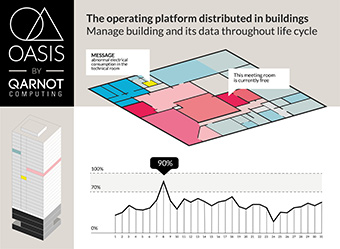The Computing Buildings project is developing ways to turn waste heat generated by IT infrastructure into a free and ecological heating source for buildings. By bringing computing capacity into buildings, the team behind this project also aims at making apartment blocks, offices and public facilities smart, to benefit their users.
- 17 January 2020
Qarnot computing turned a problem – waste heat in the ICT world – into a solution: heating buildings ecologically, for free, and at the same time making buildings smart.
To power the internet and its many cloud services, thousands of servers are brought together in data centres. These require huge amounts of energy to run, which generates heat. In fact, more than 3 % of the world’s electricity is consumed by data centres – about 40 % of which is used for cooling the servers.
A smart approach
The Computing Buildings project is using this heat to warm offices and buildings. The idea is to move away from reliance on data centres and cloud services by bringing IT services into the building itself. Traditionally, buildings may be considered smart through the use of internet-based technologies, but they are still tied to remote data centres.
This project is pioneering new hardware and software solutions which will work together to make a building independently smart. A computing heater has been designed, tested and shown to be ready for large-scale manufacturing. The project has improved its ‘middleware’, which links the cloud computer services and heating requirements. In addition, a smart building operating system has been developed to ensure the building can manage its data and processes, both locally and securely.
App-based platform
The project’s goal is to demonstrate how a smart building can work in practice for its users or residents by embedding sensors, activators and intelligent algorithms. These technologies have been brought together in a platform that can act as a building’s brain and nervous system, while providing green, free heat. Design of the platform was inspired by the smartphone industry. This approach allows building managers, residents and contractors to use apps to access and control systems.
To get ready for commercial deployment, some of the project innovations have been reviewed in demonstration sites. According to the project team, these assessments have demonstrated that the software meets all requirements. The next step is additional development of the project technologies for specific integration into buildings with specific needs, such as schools or hospitals.
Total investment and EU funding
Total investment for the project “Computing Buildings” is EUR 1 372 974, with the EU’s European Regional Development Fund contributing EUR 480 541 through the “ERDF-ESF ile-de-France et Seine” Operational Programme for the 2014-2020 programming period. The investment falls under the priority “Research and innovation”.

